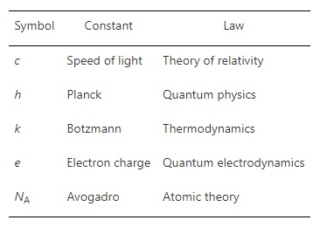https://reasonandscience.catsboard.com/t3165-the-fundamental-properties-of-nature-where-did-they-come-from
If you want to find evidence of God outside of the Bible, look into nature. 1. Start asking how questions. Start digging deep. Dig deeper and deeper until you come to the bottom, where you cannot dig further. If you do it for example with physics and start to elucidate what the fundamental properties of the cosmos are, you will eventually find the following conclusion:
second (the unit of time with the symbol s),
meter (length, m),
kilogram (mass, kg),
ampere (electric current, A),
kelvin (thermodynamic temperature, K),
mole (amount of substance, mol), and
candel (luminous intensity, cd).
The international system of units is based on fundamental properties of the universe, that is time, length, mass, electric current, thermodynamic temperature, amount of substance, and luminous intensity.
These are fundamental properties that are the most basic ones of our world. They are themselves ungrounded and they ground all of the other things. So you cannot dig deeper. Now here is the thing:
These properties are fundamental constants that are like the DNA of our Universe. They are not calculable from even deeper principles currently known. The constants of physics are fundamental numbers that, when plugged into the laws of physics, determine the basic structure of the universe. An example of a fundamental constant is Newton’s gravitational constant G, which determines the strength of gravity via Newton’s law.
These constants have a 1. fixed value, and 2. they are just right to permit a life-permitting universe. For life to emerge in our Universe the fundamental constants could not have been more than a fraction of a percent from their actual values. The BIG question is: Why is that so? These constants can’t be derived from other constants and have to be verified by experiment. Simply put: Science has no answer and does not know why they have the value that they have.
Premise 1: The fundamental constants in the universe, such as Newton's gravitational constant (G), determine the basic structure and behavior of the universe.
Premise 2: The values of these fundamental constants are not derived from other constants or deeper principles known to us.
Conclusion: Therefore, the specific values of these fundamental constants appear to be finely tuned which implies design to permit a life-permitting universe.
Explanation: The syllogism presents a design inference based on the premise that the fundamental constants are crucial for the basic structure and behavior of the universe. Since their values are not derived from other constants or deeper principles, and the specific values of these constants exhibit fine-tuning that permits our universe to be life-permitting. The inference implies that the finely-tuned values of the fundamental constants suggest the existence of a purposeful or intelligent designer.
The Standard Model of particle physics alone contains 26 such free parameters. The finely tuned laws and constants of the universe are an example of specified complexity in nature. They are complex in that their values and settings are highly unlikely. They are specified from a basically infinite range of possible non-life permitting values, in that they match the specific requirements needed for life.
The likelihood of a life-permitting universe based on natural unguided causes is less than 10^136.
One could object and say that the laws and constants of physics could not be different, in other words, they are due to physical necessity, and therefore, no fine-tuner was required. Others might say:
The laws of physics are described, not prescribed. As the universe cooled after the Big Bang, symmetries were spontaneously broken, ‘phase transitions’ took place, and discontinuous changes occurred in the values of various physical parameters (e.g., in the strength of certain fundamental interactions, or in the masses of certain species of particle). So there something did took place, that should/could not do so, if the current state of affairs was based on physical necessity. Symmetry breaking is precisely what shows that there was no physical necessity since things did change in the early universe. There was a transition zone until arriving at the composition of the fundamental particles, that make up all matter. The current laws of physics did not apply [in the period immediately following the Big Bang]. They took hold only after the density of the universe dropped below the so-called Planck density. there is no physical restriction or necessity that entails that the parameter could only have the one that is actualized. There is no principle of physics that says physical laws or constants have to be the same everywhere and always. Since that is so, the question arises: What instantiated the life-permitting parameters? There are two possibilities: Luck, or a Lawgiver.
[The Lord God] is eternal and infinite, omnipotent and omniscient, that is, he endures from eternity to eternity, and he is present from infinity to infinity; he rules all things, and he knows all things that happen or can happen.
—Isaac Newton, General Scholium to the Principia (1726)
CODATA RECOMMENDED VALUES OF THE FUNDAMENTAL PHYSICAL CONSTANTS: 2018
https://physics.nist.gov/cuu/pdf/wall_2018.pdf
Wolfram: As of Today, the Fundamental Constants of Physics (c, h, e, k, NA) Are Finally… Constant! November 16, 2018
Representatives of more than 100 countries agreed on a new definition of the base units for all weights and measures. An important vote for the future weights and measures used in science, technology, commerce and even daily life happened. The agreement was the culmination of at least 230 years of wishing and labor by some of the world’s most famous scientists. Units appear in any real-world measurement, and fundamental constants are of crucial importance for the laws of physics. Why do the constants have the values they have? Is humankind lucky that the constants have the values they have (e.g. only minute changes in the values of the constants would not allow stars to form)?
https://blog.wolfram.com/2018/11/16/as-of-today-the-fundamental-constants-of-physics-c-h-e-k-na-are-finally-constant/
International System of Units

The International System of Units (SI, abbreviated from the French Système international (d'unités)) is the modern form of the metric system. It is the only system of measurement with an official status in nearly every country in the world. It comprises a coherent system of units of measurement starting with seven base units, which are the
second (the unit of time with the symbol s),
metre (length, m),
kilogram (mass, kg),
ampere (electric current, A),
kelvin (thermodynamic temperature, K),
mole (amount of substance, mol), and
candel (luminous intensity, cd).
https://en.wikipedia.org/wiki/International_System_of_Units
Heather Demarest Fundamental Properties and the Laws of Nature 2015
Fundamental properties are the most basic properties of a world. In terms of the new, popular notion of grounding, fundamental properties are themselves ungrounded and they (at least partially) ground all of the other properties. The laws metaphysically determine what happens in the worlds that they govern. These laws have a metaphysically objective existence. Laws systematize the world. Fundamental properties can be freely recombined. There are also no necessary connections between distinct existences. One law of nature does not necessarily depend on another. These laws have intrinsic properties, which they have in virtue of the way they themselves are.
https://sci-hub.ren/10.1111/phc3.12222
Miguel A. Martin-Delgado The new SI and the fundamental constants of nature 16 October 2020
The fundamental constants are like the DNA of our Universe. constants such as those in table 1 are not calculable from the first principles currently known.
Symbol Constant Law
c Speed of light Theory of relativity
h Planck Quantum physics
k Botzmann Thermodynamics
e Electron charge Quantum electrodynamics
NA Avogadro Atomic theory
The speed of light in vacuum is a fundamental constant of nature which is independent of the other four fundamental constants:
Newton's gravitational constant,
Boltzmann's constant which arises in statistical physics,
Planck constant which arises in quantum physics, and the
Vacuum permittivity which refers to electromagnetism.
A fundamental constant is something we can measure but not derive. So to know something more precise about the value of the speed of light would need a revolutionary change to our laws of physics that reduced the number of fundamental constants.
http://www2.phys.canterbury.ac.nz/~dlw24/c.html

Schematic relationship between the base units of the new international system SI and its associated natural constants. In the central part the units and their dependencies among each other appear: the second influences the definition of five units, while the mole appears decoupled. The symbols of the constants used to define the units appear on the outside.

Table 1: The five universal constants of nature and their corresponding laws they are associated with. The laws of physics and chemistry allow us to describe natural phenomena once the values of the constants are known.
https://iopscience.iop.org/article/10.1088/1361-6404/abab5e#ejpabab5es4

Last edited by Otangelo on Sat Jul 01, 2023 12:40 pm; edited 36 times in total


 , and is of fundamental importance in quantum mechanics. A photon's energy is equal to its frequency multiplied by the Planck constant. Due to mass–energy equivalence, the Planck constant also relates mass to frequency.
, and is of fundamental importance in quantum mechanics. A photon's energy is equal to its frequency multiplied by the Planck constant. Due to mass–energy equivalence, the Planck constant also relates mass to frequency.